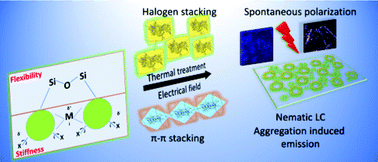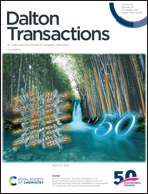Dual crystalline–amorphous salen–metal complexes behave like nematic droplets with AIEgens vistas†
Abstract
A series of metal salen complexes, original in view of the presence in their structure of a highly flexible and hydrophobic spacer, were prepared on the basis of the reaction of 1,3-bis(3-aminopropyl)tetramethyldisiloxane with 3,5-dichloro-, 3,5-dibromo- and 3-hydroxy-salicylaldehyde and various metal ions (Co2+, Ni2+, Cu2+ and Zn2+). The isolated products were completely characterized from the structural point of view by FTIR, NMR, elemental analysis and single crystal X-ray diffraction, and further investigated from the perspective of the behavior induced mainly by the structural peculiarities. Emphasis is placed on self-assembly properties, both in bulk and in solution, depending on temperature, solvent nature and concentration, including thermotropic and lyotropic liquid crystals (LC). LCs that appear in the form of nematic toroidal droplets have been fully demonstrated by polarized optical microscopy (POM), differential scanning calorimetry (DSC), broadband dielectric spectroscopy (BDS) and fluorescence anisotropy studies. The fluorescence analysis results revealed the aggregation-induced emission (AIE) phenomenon, where the emission occurs only for liquid crystals, with a few exceptions. Because these complexes can exist in both amorphous and crystalline states, it raised the question of how properties, such as electrical, change when switching from one state to another. These were well highlighted by DSC, BDS, PXRD, FTIR and fluorescence anisotropy.

- This article is part of the themed collection: Spotlight Collection: Aggregation induced luminescence of metal complexes


 Please wait while we load your content...
Please wait while we load your content...